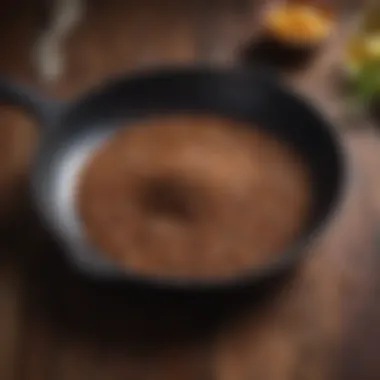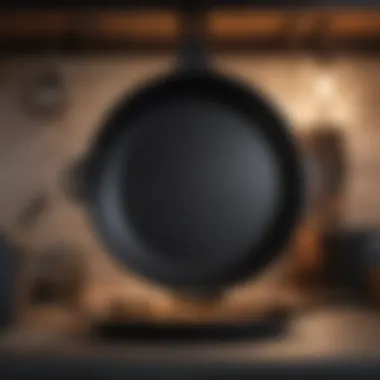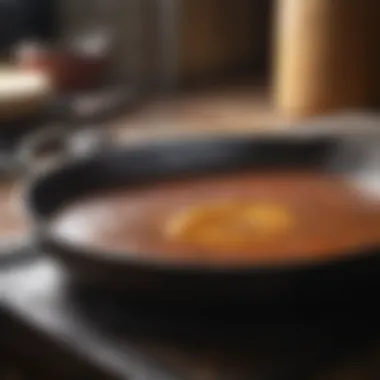Essential Tips for Properly Caring for Your Cast Iron Skillet After Cooking


Key Points for Maintaining Your Cast Iron Skillet:
After enjoying a delicious meal prepared in your cast iron skillet, it's crucial to provide the proper care to ensure its longevity and performance. The following steps will guide you through the essential cleaning methods and seasoning techniques tailored for optimal maintenance.
Cleaning Methods:
To maintain the pristine condition of your cast iron skillet, avoid using harsh detergents or abrasive scrubbers that can damage the seasoning. Instead, opt for gentle hand washing with warm water and a soft sponge. Stubborn food residue can be loosened by boiling water in the skillet or using a paste of kosher salt and water.
Seasoning Techniques:
Seasoning your cast iron skillet regularly is paramount to prevent rusting and maintain a non-stick surface. After cleaning, ensure the skillet is completely dry, then apply a thin layer of cooking oil or fat to all surfaces, including the handle. Place the skillet upside down in an oven preheated to 350°F (177°C) and let it bake for one hour. Repeat this process to build up a robust seasoning.
Relevance of the Topic:
The proper care of a cast iron skillet transcends mere maintenance; it is a culinary art form that guarantees the exquisite flavor of your dishes and the endurance of your cookware. By mastering these techniques, you not only uphold the heritage of cast iron cooking but also elevate your culinary prowess.
Synthesizing the Information Presented:
In essence, the meticulous care of your cast iron skillet after cooking encompasses a gentle yet deliberate approach. By understanding the significance of proper cleaning and seasoning, you embark on a journey towards culinary excellence and enduring kitchen companionship. Let each sizzle and sear in your skillet be a testament to your dedication to preserving a time-honored tradition.
Introduction
In the realm of culinary essentials, the cast iron skillet stands as a stalwart, a versatile tool cherished by chefs and home cooks alike for its exceptional heat retention and even cooking. However, the journey doesn't end with the last sizzle of food in the skillet; rather, proper care post-cooking is crucial to maintain its performance and durability. This article is a comprehensive guide on the requisite steps to preserve your trusty cast iron skillet for years to come.
Understanding the Importance of Post-Cooking Care


Post-cooking care for your cast iron skillet is not merely a routine chore but an investment in its longevity. By dedicating time and attention to cleaning and maintenance, you not only ensure the removal of food residues and impurities but also prevent the onset of rust and deterioration. Regular upkeep keeps your skillet in prime condition, ready to yield delicious culinary creations whenever summoned. With each wash and seasoning, you uphold the legacy of your cast iron skillet, passing on a seasoned heirloom to future generations.
Impact of Neglecting Maintenance on Cast Iron Skillets
The consequences of neglecting post-cooking care for your cast iron skillet can be dire, leading to a myriad of issues that compromise its functionality and lifespan. Failure to clean the skillet promptly after use can result in stubborn food build-up, affecting both the flavor of subsequent dishes and the skillet's seasoning. Rust, the arch-nemesis of cast iron, can take root in neglected skillets, leading to corrosion that is challenging to reverse. By overlooking maintenance rituals such as seasoning and proper storage, you risk diminishing the skillet's performance and curtailing its potential lifespan. Neglect is not an option when it comes to preserving the integrity of your cast iron skillet.
Cleaning Techniques
Cleaning techniques play a pivotal role in maintaining the integrity of your cast iron skillet post-cooking. The longevity and performance of your kitchen essential depend significantly on how well you clean it after use. By utilizing the appropriate cleaning methods, you can ensure that your skillet remains in top condition for years to come.
Hand Washing
Avoid Using Harsh Soaps
When it comes to hand washing your cast iron skillet, one crucial aspect to consider is to avoid using harsh soaps. Harsh soaps can strip the skillet of its seasoning, leading to potential damage and decreased performance over time. Opting for milder, gentle soaps or specialized cast iron cleaning products is a more suitable choice for maintaining the skillet's seasoning and overall quality.
Mild soaps help in preserving the skillet's seasoning while effectively removing food residues and grease. This gentle approach ensures that your cast iron skillet remains in optimal condition without compromising its cooking properties. By avoiding harsh soaps, you prioritize the longevity and functionality of your cherished kitchen tool.
Utilize a Mild Scrubber
In conjunction with using gentle soaps, utilizing a mild scrubber is another essential practice when hand washing your cast iron skillet. A mild scrubber, such as a soft-bristled brush or non-abrasive sponge, aids in removing stubborn food particles without scratching or damaging the skillet's surface.
The key characteristic of a mild scrubber lies in its ability to effectively clean the skillet without causing abrasions. This gentle yet efficient cleaning tool ensures that your cast iron skillet stays in top-notch condition after each use. By incorporating a mild scrubber into your cleaning routine, you can uphold the quality and performance of your skillet for the long term.
Avoiding Dishwasher Usage
While modern dishwashers offer convenience, it is vital to avoid using them for cleaning your cast iron skillet. The harsh detergents and high heat in dishwashers can degrade the skillet's seasoning and promote rust formation. Opting for hand washing ensures a more controlled and gentle cleaning process, preserving the integrity of the skillet.


Drying Methods
Thoroughly Towel Dry
After cleaning your cast iron skillet, it is crucial to thoroughly towel dry it to prevent the formation of rust. By ensuring that all moisture is removed, you safeguard the skillet against rusting and extend its lifespan. A thorough towel drying process helps in maintaining the pristine condition of your skillet for future culinary endeavors.
Air Drying
Alternatively, air drying your cast iron skillet is another effective method to prevent moisture build-up and potential rust formation. By allowing the skillet to air dry completely before storage, you minimize the risk of any water-related damage and ensure that it is ready for future use. This gentle drying process complements the cleaning routine, adding an extra layer of protection to your valuable kitchen tool.
Seasoning Your Cast Iron Skillet
When it comes to cast iron skillet care, seasoned properly elevates your cooking experience to new heights. Seasoning involves creating a protective layer on the pan's surface by coating it with oil and heating it, which not only enhances the skillet's non-stick properties but also prevents rusting and maintains its durability. Proper seasoning allows for better heat distribution, making your dishes cook more evenly and achieve that desired sear. This process also adds flavor to your food, enriching the depth of every dish prepared. In the world of culinary excellence, seasoning your cast iron skillet is akin to unlocking a treasure trove of immersive flavors and textures.
Applying a Thin Layer of Oil
The application of a thin layer of oil is a critical step in the seasoning process of your cast iron skillet. This thin coating of oil functions as a shield against moisture and helps in building up that coveted non-stick surface. Selecting the right oil is essential, with many opting for oils with high smoke points such as vegetable or flaxseed oil. The key is to apply the oil sparingly, ensuring an even coverage throughout the surface. This simple yet meticulous task sets the foundation for a well-seasoned skillet, enhancing its longevity and performance.
Baking for Optimal Seasoning
Once the oil is applied, the skillet is ready to undergo the baking process to achieve optimal seasoning. Baking at a high temperature allows the oil to polymerize, forming a durable coating on the skillet's surface. This curing process transforms the oil into a smooth, resilient layer that can withstand high cooking temperatures and frequent use. As the skillet bakes, you might notice a subtle change in color, indicating the development of the seasoning layer. Investing time in this step ensures that your cast iron skillet is primed for exceptional performance each time it meets the stove.
Storing Your Skillet
Proper storage of your cast iron skillet is vital to preserve its seasoned surface and prevent damage. To maintain the integrity of the seasoning, it's crucial to store the skillet in a dry environment to avoid moisture build-up, which can lead to rust formation. Additionally, storing the skillet without stacking it with other cookware prevents friction and scratching, safeguarding the seasoning layer. By adhering to these storage practices, you ensure that your cast iron skillet remains in top condition, ready to deliver culinary delights with each use.


Preventing Moisture Build-Up
Preventing moisture build-up is a fundamental aspect of preserving the seasoning on your cast iron skillet. Moisture can be detrimental to the seasoning layer, causing it to break down and resulting in potential rust formation. By thoroughly drying your skillet after each use and storing it in a dry area, you mitigate the risk of moisture seeping into the pan and compromising its integrity.
Avoiding Stacking with Other Cookware
Avoiding stacking your cast iron skillet with other cookware is essential to prevent damage to the seasoning. Stacking can lead to friction between the pans, causing abrasions that wear down the seasoning layer over time. By storing your skillet individually, you ensure that it retains its seasoned surface for prolonged periods, ready to deliver culinary excellence whenever called upon.
Common Mistakes to Avoid
Emphasizing the significance of steering clear of common mistakes is paramount when aiming to prolong the life and performance of your cast iron skillet. Often overlooked, these mistakes can lead to irreversible damage and compromise the quality of your cooking. By grasping the dos and don'ts, you equip yourself with the knowledge necessary to maintain your skillet in top condition for years to come. Proper care extends beyond the ordinary, offering a valuable lesson in the art of preservation and longevity. Understanding the nuances of common mistakes sets the foundation for impeccable skillet care.
Using Abrasive Cleaning Tools
One of the most detrimental errors when handling a cast iron skillet is the use of abrasive cleaning tools. Scrubbers or cleaners with harsh bristles can strip away the skillet's seasoned layer, leaving it vulnerable to rust and a decline in non-stick properties. Opting for gentler alternatives such as soft sponges or nylon brushes ensures thorough cleaning without sacrificing the skillet's integrity. The key lies in preserving the seasoned surface while effectively removing residues, striking a delicate balance between cleanliness and maintenance. By steering clear of abrasive tools, you safeguard the essence of your skillet's performance and durability.
Neglecting to Re-Season Periodically
Neglecting the periodic re-seasoning of your cast iron skillet can result in a lackluster cooking experience and diminished non-stick capabilities. Seasoning acts as a protective barrier, preventing rust and enhancing the skillet's natural non-stick properties. Over time, cooking oils polymerize, forming a slick surface that facilitates food release and imparts flavor. Regularly re-seasoning your skillet replenishes this layer, maintaining its functionality and resilience. By overlooking this crucial step, you risk exposing your skillet to potential damage and compromising its performance. Incorporating re-seasoning as part of your maintenance routine ensures the longevity and quality of your cast iron cookware.
Ignoring Proper Storage Practices
Proper storage practices play a pivotal role in preserving the condition and potency of your cast iron skillet. Ignoring these practices can lead to issues such as rust, odors, and deterioration of the seasoned layer. Storing a damp or wet skillet promotes rust formation, detracting from its aesthetic appeal and cooking efficiency. Additionally, stacking cast iron cookware without protective layers can cause scratches and chips, impacting not only the skillet's appearance but also its functionality. Adhering to proper storage guidelines, such as ensuring thorough drying before storing and using separators between stacked items, shields your skillet from potential harm. By integrating these practices into your routine, you uphold the quality and longevity of your beloved cast iron skillet.
Conclusion
Proper care of a cast iron skillet after cooking is an essential practice that directly impacts its longevity and cooking performance. Neglecting this post-cooking care routine can lead to detrimental effects on your skillet that may affect the flavor and quality of your dishes. By following the guidelines outlined in this article, you are not just maintaining a kitchen tool but preserving a piece of culinary history passed down through generations.
The proper care of a cast iron skillet extends beyond mere maintenance; it is a testament to tradition and craftsmanship. Each step, from hand washing to seasoning, plays a crucial role in enhancing the skillet's natural non-stick properties and preserving its durability over time. This attention to detail ensures that the skillet performs optimally, providing you with perfectly cooked meals every time.
One of the key benefits of diligently caring for your cast iron skillet is the development of a seasoned surface that improves with each use. This seasoning not only enhances the flavor of your dishes but also contributes to the skillet's unique characteristics, making every meal a culinary delight. Additionally, regular seasoning helps prevent rusting and maintains the skillet's smooth surface, ensuring effortless cooking and cleaning.
Furthermore, understanding the impact of common mistakes, such as using abrasive cleaning tools or neglecting to re-season periodically, emphasizes the significance of proper care practices. By avoiding these pitfalls and incorporating recommended techniques, you are safeguarding your investment and guaranteeing the continued excellence of your cast iron skillet for years to come.



